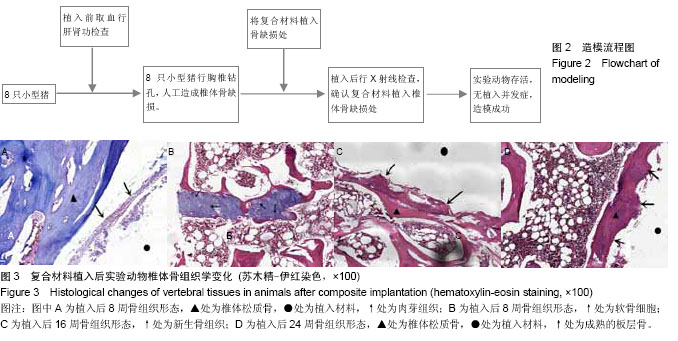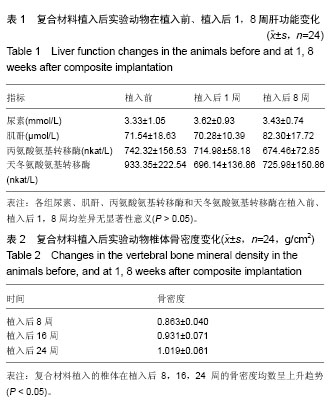| [1] 廖世波,赖琛,张志雄,等.骨修复复合材料及其相关问题的研究进展[J].中国生物医学工程学报,2012,31(5):755-761.
[2] Mills LA, Simpson AH. In vivo models of bone repair. J Bone Joint Surg Br. 2012;94(7):865-874.
[3] Kolk A, Handschel J, Drescher W, et al. Current trends and future perspectives of bone substitute materials-from space holders to innovative biomaterials. J Craniomaxillofac Surg. 2012;40(8):706-718.
[4] Heo SJ, Kim SE, Wei J, et al. Fabrication and characterization of novel nano-and micro-HA/PCL composite scaffolds using a modified rapid prototyping process. J Biomed Mater Res A. 2009;89(1):108-116.
[5] 李鸿.多孔纳米寒基磷灰石/聚酸胺复合骨修复材料的研究[D].成都:四川大学,2007.
[6] Wang X, Li Y, Wei J, et al. Development of biomimetic nano-hydroxyapatite/poly (hexamethylene adipamide) composites. Biomaterials. 2002;23(24):4787-4791.
[7] Thian ES, Huang J, Ahmad Z, et al. Influence of nanohydroxyapatite patterns deposited by electrohydrodynamic spraying on osteoblast response. J Biomed Mater Res A. 2008;85(1):188-194.
[8] Abd EI-Fatah H, Helmy Y, EI-Kholy B, et al. In vivo animal histomorphometric study for evaluating biocompatibility and osteointegration of nano-hydroxyapatite as biomaterials in tissue engineering. J Egypat Natl Canc lust. 2010;22(4): 241-250.
[9] Zhang X, Zhang Y, Zhang X, et al. Mechanical properties and cytocompatibility of carbon fibre reinforced nano-hydroxyapatite/polyamide66 ternary biocomposite. J Mech Behav Biomed Mater. 2015;42:267-273.
[10] Zhang X, Li Y, Lv G, et al. Mechanical properties and cytocompatibility of carbon fibre reinforced nano-hydroxyapatite/polyamide66 ternary biocomposite. Polym Degrad Stabil. 2006;91(5):1202-1207.
[11] Kanyama M, Hashimoto T, Shigenobu K, et al. Pitfall of anterior cervical fusion using titanium mesh and local autograft. J Spine Disord Tech. 2003;16(6):513-518.
[12] Das K, Couldwell WT, Sava G, et al. Use of cylindrical titanium mesh and locking plates in anterior cervical fusion. J Neurosurg. 2001;94(1 Suppl):174-178.
[13] Wang L, Song Y, Pei F, et al. Application of nano-hydroxyapatite/ polyamide 66 cage in reconstruction of spinal stability after resection of spinal tumor. Zhongguo Xiu Fu Chong Jian Wai Ke Za Zhi. 2011;25(8):941-945.
[14] Nandi SK, Roy S, Mukherjee P, et al. Orthopaedic applications of bone graft & graft substitutes: a review. Indian J Med Res. 2010;132:15-30.
[15] 王岩松,刘丹平,张元和,等.纳米羟基磷灰石/聚酰胺66骨填充材料与自体骨修复良性骨肿瘤植入后骨缺损的对比研究[J].军医进修学院学报,2011,23(4):373-374.
[16] 杨曦,宋跃明,孔清泉,等.纳米羟基磷灰石/聚酰胺66椎间融合器植骨融合治疗下腰椎退变性疾病的近期疗效[J].中国修复重建外科杂志,2012,26(12):1420-1424.
[17] 陈豪.比较纳米羟基磷灰石/聚酰胺66人工椎体与自体髂骨在颈椎前路减压融合中的应用[J].中国组织工程研究,2011,15(12): 2195-2198.
[18] 修鹏,刘利岷,宋跃明,等.纳米羟基磷灰石/聚酰胺66椎体支撑体在脊髓型颈椎病前路手术重建中的应用[J].中国骨与关节外科,2009, 2(5):23-26.
[19] Zhang Y, Quan ZX, Zhao ZH, et al. Evaluation of anterior cervical reconstruction with titanium mesh cages versus nano- hydroxyapatite/polyamide66 cages after 1- or 2-level corpectomy for multilevel cervical spondylotic myelopathy: a retrospective study of 117 patients. PLoS One. 2014;9(5): e96265.
[20] Zhang ZH, Jiang DM, Ou YS, et al. A hollow cylindrical nano-hydroxyapatite/polyamide composite strut for cervical reconstruction after cervical corpectomy. J Clin Neurosci. 2012;19(4):536-540.
[21] Yang X, Song Y, Liu L, et al. Anterior reconstruction with nanohydroxyapatite/polyamide-66 cage after thoracic and lumbar corpectomy. Orthopedics. 2012;35(1):66-73.
[22] Yang X, Chen Q, Song Y, et al. Comparison of anterior cervical fusion by titanium mesh cage versus nano-hydroxyapatite/polyamide cage following single-level corpectomy. Int Orthop. 2013;37(12):2421-2427.
[23] 朱雪松,杨惠林,张志明,等.椎体成形术骨缺损动物模型的制备和评价[J].苏州大学学报(医学版),2005,(4):599-601.
[24] 杨晓波,裴福兴,严永刚,等.聚氨基酸复合纳米羟基磷灰石的体内生物相容性实验研究[J].中国矫形外科杂志,2010,(21): 1809-1813.
[25] Yoshikawa H, Myoui A. Bone tissue engineering with porous hydroxyapatite ceramics. J Artif Organs. 2005;8(3): 131-136.
[26] 桑裴铭.医用纳米羟基磷灰石/聚酰胺66复合生物材料研究现状及进展[J].医学综述,2012;18(13):2072-2074.
[27] Mastrogiacomo M, Muraglia A, Komlev V, et al. Tissue engineering of bone: search for a better scaffold. Orthod Craniofac Res. 2005;8(4):277-284.
[28] 强小虎,王彦平.聚磷酸钙纤维/纳米羟基磷灰石/聚乳酸复合材料的降解行为[J].中国组织工程研究与临床康复,2008,(27): 5275-5278.
[29] 卢晓英,王秀红,屈树新,等.纳米羟基磷灰石/壳聚糖杂化材料的制备[J].无机材料学报,2008,(2):332-336.
[30] 杨辉,张林,张宏,等.丝素蛋白/羟基磷灰石复合材料的制备及性能表征[J].复合材料学报,2007,(3):141-146.
[31] Wei J, Li YB. Tissue engineering scaffold material of nano-apatitecrystals and polyamide composite. Eur Poly J. 2004;40(3):509-515.
[32] Yang B, Ou Y, Jiang D, et al. Early clinical effect of intervertebral fusion of lumbar degenerative disease using nano-hydroxyapatite/polyamide 66 intervertebral fusion cage. Sheng Wu Yi Xue Gong Cheng Xue Za Zhi. 2014;31(5): 1102-1106.
[33] Sang PM, Zhang M, Chen BH, et al. Radiological study on the n-HA/PA66 cage used in the transforaminal lumbar interbody fusion. Zhongguo Gu Shang. 2014;27(8):654-657.
[34] Yang X, Song YM, Liu LM, et al. Anterior decompression and fusion with n-HA/PA66 cage for the treatment of lower cervical fracture and dislocation. Zhongguo Gu Shang. 2014;27(2): 92-96.
[35] Yang X, Liu L, Song Y, et al. Outcome of single level anterior cervical discectomy and fusion using nano-hydroxyapatite/ polyamide-66 cage. Indian J Orthop. 2014;48(2):152-157.
[36] Yang X, Chen Q, Liu L, et al. Comparison of anterior cervical fusion by titanium mesh cage versus nano-hydroxyapatite/polyamide cage following single-level corpectomy. Int Orthop. 2013;37(12):2421-2427.
[37] Ryu SY, Kwak SY. Role of electrical conductivity of spinning solution on enhancement of electrospinnability of polyamide 6,6 nanofibers. J Nanosci Nanotechnol. 2013;13(6): 4193-4202.
[38] Su B, Peng X, Jiang D, et al. In vitro and in vivo evaluations of nano-hydroxyapatite/polyamide 66/glass fibre (n-HA/PA66/GF) as a novel bioactive bone screw. PLoS One. 2013;8(7):e68342.
[39] Liu M, Zhang Q, Zhou L, et al. Research on the microstructure of antibacterial nanocomposite membrane and it's biocompatibility as a guided bone regeneration membrane. Hua Xi Kou Qiang Yi Xue Za Zhi. 2013;31(2):127-130, 135.
[40] James D, Varga A, Jesperson GD, et al. Identification and complete genome analysis of a virus variant or putative new foveavirus associated with apple green crinkle disease. Arch Virol. 2013;158(9):1877-1887.
[41] Qiao B, Li J, Zhu Q, et al. Bone plate composed of a ternary nano-hydroxyapatite/polyamide 66/glass fiber composite: biomechanical properties and biocompatibility. Int J Nanomedicine. 2014;9:1423-1432.
[42] Xiong Y, Ren C, Zhang B, et al. Analyzing the behavior of a porous nano-hydroxyapatite/polyamide 66 (n-HA/PA66) composite for healing of bone defects.Int J Nanomedicine. 2014;9:485-494.
[43] Qian X, Yuan F, Zhimin Z, et al. Dynamic perfusion bioreactor system for 3D culture of rat bone marrow mesenchymal stem cells on nanohydroxyapatite/polyamide 66 scaffold in vitro.J Biomed Mater Res B Appl Biomater. 2013;101(6):893-901.
[44] Zhang SL, Zhou Y, Duan H, et al. Repairing bone defect with nano-hydroxyapatite and polyamide 66 composite after giant cell tumor operations. Sichuan Da Xue Xue Bao Yi Xue Ban. 2012;43(3):373-377.
[45] Lu M, Jiang D, Quan Z, et al. Experimental research of antibacterial property and release characteristics of Titania and Ag containing nano-hydroxyapatite/polyamide 66 composite bone filling material in vitro. Zhongguo Xiu Fu Chong Jian Wai Ke Za Zhi. 2010;24(6):691-695.
[46] Xu Q, Lu H, Zhang J, et al. Tissue engineering scaffold material of porous nanohydroxyapatite/polyamide 66. Int J Nanomedicine. 2010;5:331-335.
[47] Liang X, Jiang D, Ni W. Clinical observation on nano-hydroxyapatite and polyamide 66 composite in repairing bone defect due to benign bone tumor. Zhongguo Xiu Fu Chong Jian Wai Ke Za Zhi. 2007;21(8):785-788.
[48] Zheng Q, Zhou LW, Wei SC, et al. Experimental study on the reconstruction of mandibular defects with a new bioactive artificial bone nano-hydroxyapatite/polyamide-66 in dogs. Zhonghua Kou Qiang Yi Xue Za Zhi. 2004;39(1):60-62.
[49] Wei S, Li Y, Zheng Q, et al. Study on injectable bioactive bone repairing material of nano-hydroxyapatite and polyamide-66 composite. Sheng Wu Yi Xue Gong Cheng Xue Za Zhi. 2003; 20(4):590-593 |


.jpg)